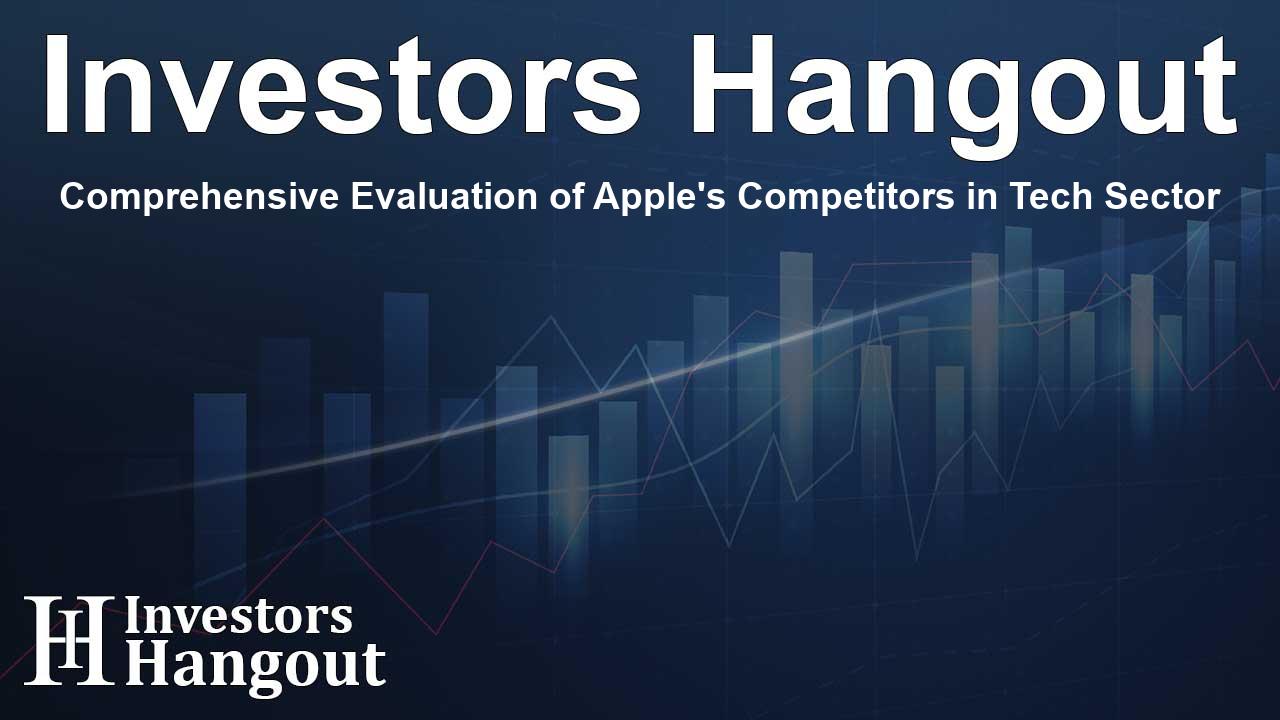Comprehensive Evaluation of Apple's Competitors in Tech Sector

Exploring the Competitive Landscape of Apple Inc.
In a business realm characterized by rapid changes and intense rivalry, assessments of leading companies are paramount for smart investment decisions. This article sets out to deeply analyze how Apple stands next to its main competitors in the Technology Hardware, Storage & Peripherals sector. We will explore important financial metrics, market dynamics, and growth prospects, offering insights into Apple's standing within this competitive landscape.
Background Information on Apple
Apple is recognized as one of the frontrunners in the global market, boasting a diverse range of products across hardware and software tailored for individual and business users. The iPhone plays a critical role in Apple's revenue generation, while other products like Mac, iPad, and Apple Watch seamlessly integrate into an expansive software ecosystem centered around it. The company has consistently added advanced features, including streaming services, subscription models, and AR applications. Apple develops proprietary software and silicon but collaborates with manufacturing partners for assembly and production.
Key Financial Metrics and Comparisons
Understanding the performance metrics is crucial in our evaluation, so we dive into comprehensive financial data comparing Apple against its competitors.
| Company | P/E Ratio | P/B Ratio | P/S Ratio | Return on Equity | EBITDA (in billions) | Gross Profit (in billions) | Revenue Growth |
|---|---|---|---|---|---|---|---|
| Apple Inc | 33.09 | 47.50 | 8.07 | 37.11% | $32.25 | $44.87 | 5.08% |
| Super Micro Computer Inc | 26.49 | 4.56 | 1.42 | 1.72% | $0.14 | $0.44 | 19.48% |
| Hewlett Packard Enterprise Co | 20.43 | 1.17 | 0.90 | -4.4% | $0.87 | $2.17 | 5.87% |
| Western Digital Corp | 22.53 | 4.43 | 1.48 | 5.86% | $0.28 | $0.91 | 30.94% |
| NetApp Inc | 18.98 | 20.73 | 3.42 | 33.42% | $0.43 | $1.19 | 3.84% |
| Pure Storage Inc | 147.37 | 14.71 | 5.92 | -1.1% | $0.04 | $0.54 | 12.26% |
| Eastman Kodak Co | 12.60 | 0.87 | 0.52 | -1.66% | $0.02 | $0.05 | -0.8% |
| Turtle Beach Corp | 19.59 | 2.42 | 0.80 | -0.55% | $0.0 | $0.02 | 14.42% |
| Average | 38.28 | 6.98 | 2.07 | 4.76% | $0.25 | $0.76 | 12.29% |
Financial Insights via Key Performance Indicators
Analyzing Apple's performance metrics reveals notable trends impacting its competitive standing:
-
The Price to Earnings ratio for Apple is observed at 33.09, which is lower than the industry average by 0.86x. This potentially showcases that the stock offers growth opportunities at a fair valuation.
-
Apple's Price to Book ratio is significantly higher at 47.5, which suggests it might be overvalued when compared to its competition.
-
With a Price to Sales ratio of 8.07, Apple may also be perceived as overvalued in terms of sales efficiency.
-
High Return on Equity (ROE) of 37.11% indicates that Apple effectively uses its equity to generate profits, signifying strong growth potential.
-
Apple's EBITDA of $32.25 billion is substantially above industry averages, reflecting strong profitability and solid cash flow management.
-
Additionally, a gross profit of $44.87 billion showcases exceptional earnings from its core operational activities.
-
Despite these strong indicators, the company faces a revenue growth decline at 5.08%, which is below the industry average, highlighting a tougher sales landscape.
Debt Management Analysis
Evaluating the debt-to-equity ratio is vital for understanding Apple's financial leverage and health. In comparison to peers:
-
Apple's debt-to-equity ratio is calculated at a moderate 1.47, positioning it favorably among its closest competitors.
-
This ratio suggests a balanced approach to leveraging debt while maintaining a stable financial structure.
Summarizing Key Insights
Apple's performance within the Technology Hardware, Storage & Peripherals industry illustrates a mixed outlook. The low PE ratio compared to peers hints at potential undervaluation while high PB and PS ratios indicate strong market confidence in Apple's sales and asset values. The impressive ROE, EBITDA and gross profit margins display solid profitability; however, the revenue growth decline raises concerns about future performance and necessitates adaptive strategies in line with evolving market trends.
Frequently Asked Questions
What is the primary focus of this comparison?
This article compares Apple Inc. against its competitors in the Technology Hardware, Storage, and Peripherals industry, analyzing financial metrics and market positioning.
Why is Apple’s iPhone important for its sales?
The iPhone is a cornerstone of Apple’s revenue generation, often driving sales for other products while integrating into its broader software ecosystem.
How does Apple's Pe ratio compare with its industry peers?
Apple's PE ratio is lower than the industry average, suggesting potential for growth at reasonable valuations.
What does the debt-to-equity ratio indicate about Apple?
The debt-to-equity ratio of 1.47 signifies a balanced financial structure, indicating prudent use of debt versus equity financing.
What challenges does Apple face in the current market?
Apple is experiencing a decline in revenue growth, which could indicate a need for a strategic approach to stimulating sales in a competitive market environment.
About The Author
Contact Thomas Cooper privately here. Or send an email with ATTN: Thomas Cooper as the subject to contact@investorshangout.com.
About Investors Hangout
Investors Hangout is a leading online stock forum for financial discussion and learning, offering a wide range of free tools and resources. It draws in traders of all levels, who exchange market knowledge, investigate trading tactics, and keep an eye on industry developments in real time. Featuring financial articles, stock message boards, quotes, charts, company profiles, and live news updates. Through cooperative learning and a wealth of informational resources, it helps users from novices creating their first portfolios to experts honing their techniques. Join Investors Hangout today: https://investorshangout.com/
The content of this article is based on factual, publicly available information and does not represent legal, financial, or investment advice. Investors Hangout does not offer financial advice, and the author is not a licensed financial advisor. Consult a qualified advisor before making any financial or investment decisions based on this article. This article should not be considered advice to purchase, sell, or hold any securities or other investments. If any of the material provided here is inaccurate, please contact us for corrections.
